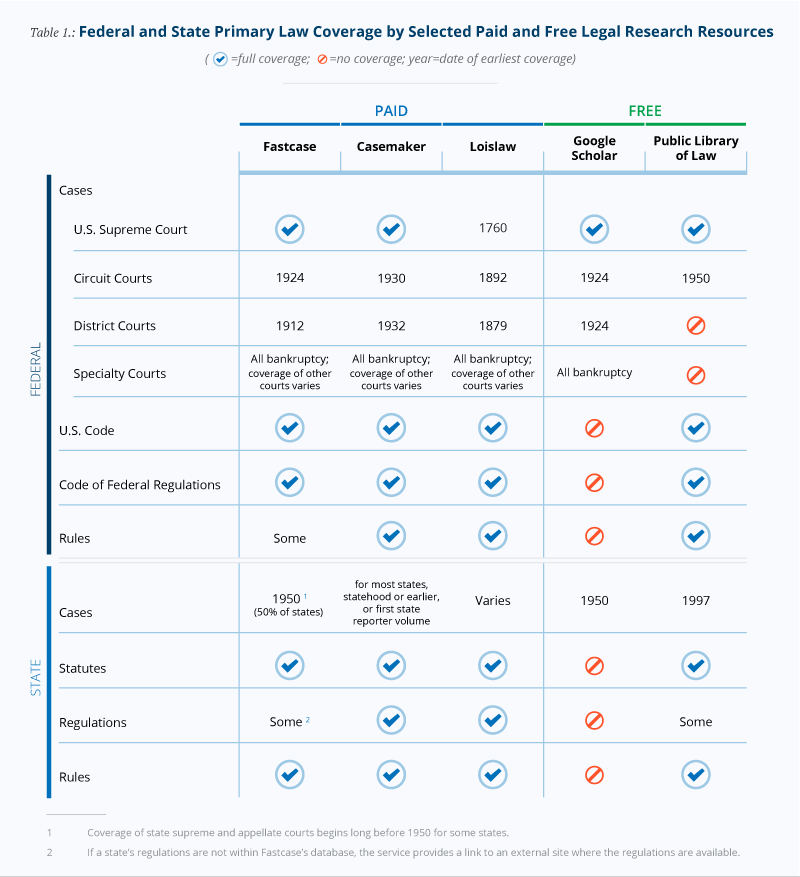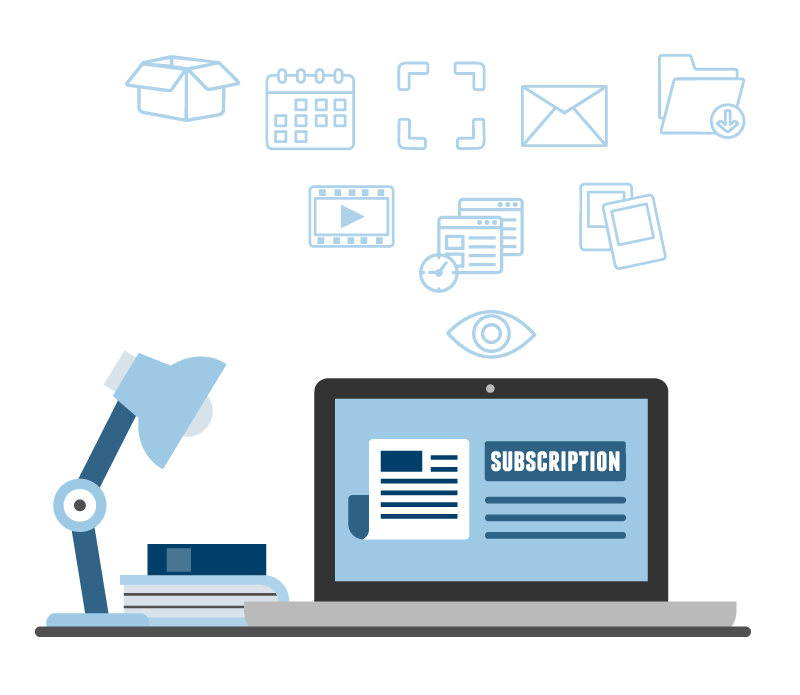With a wide variety of paid and free options now available, there has never been a better time to be an online legal research consumer. When evaluating the legal research tools discussed below, consider your answers to these questions:
Do you need access to state and/or federal materials? Multistate?
What kinds of materials do you use most often: primary sources, secondary sources or forms?
How much do you rely on editorial enhancements in cases (such as headnotes) and citators (such as depth of treatment signals).
This blog post is from the MyCase eBook “Choosing the Right Legal Research Tool for Your Firm” by Lisa Solomon. You can download the full PDF for free here.
Does it Pay to Pay for Legal Research?
Deciding whether to use a subscription (paid) or free service is about more than your budget. Subscription services offer a number of benefits. First, they can be more efficient than free options because they offer robust proximity searching, field restrictions and result filtering, while the free options generally don’t (the Public Library of Law is an exception).

Second, they offer live research and technical support. Third, they offer citators (Google Scholar is the only free option that does so)*. Finally, while Fastcase (acquired LoisLaw since this article was written) and Casemaker don’t publish proprietary secondary sources, LexisNexis, Thomson Reuters (which offers WestlawNext) and Bloomberg BNA all publish treatises, form books and other secondary materials that are available only through their respective platforms.
* For an in-depth comparison of citators, read Are All Citators Created Equal? A Comparison of Google Scholar, Fastcase, Casemaker, LexisNexis, WestlawNext and Bloomberg by Carole Levitt and Mark Rosch.
The 800-lb gorillas: WestlawNext and Lexis Advance
The most well-known legal research services, with the broadest coverage in both primary and secondary sources, are WestlawNext (from Thomson Reuters) and Lexis Advance (from LexisNexis). These services offer a number of benefits when compared to the other paid services.
First, cases on both services are editorially enhanced with case summaries and headnotes (classified in the key number system on WestlawNext and the Lexis Topics system on Lexis Advance), which can speed up your research. Second, they offer annotated state and federal statutes; annotated federal regulations; and historical versions of some state codes. Third, they generally have complete historical state case law coverage. Fourth, they offer the ability to see search results (snippets) from secondary sources outside a subscriber’s plan, and to access relevant documents for an additional charge. Fifth, they offer 24/7 live technical and research support. Finally, they’re the only services that carry American Law Reports.

The primary downside to these services involves the buying process. Both require you to commit to at least a one-year contract. Additionally, until fairly recently, the only way to subscribe to Lexis or Westlaw was to negotiate with a sales representative, a process that doesn’t seem to make sense in the age of online shopping. Although you can now purchase WestlawNext and Lexis Advance online instead of dealing with a sales representative, you shouldn’t, for two reasons.
First, not all plans are available online. For example, the LexisNexis web store doesn’t carry even standard Lexis Advance plans for many states; at the Thomson Reuters website, you can’t purchase many WestlawNext add-on plans (such as law journals) or comprehensive plans that include primary law and different combinations of secondary sources. Second, sales representatives have the discretion to give discounts on contracts of any length— including one-year contracts. According to the sales representatives from both companies, this means that any plan available from either company’s website will always cost less if you purchase it through a sales representative (assuming you take advantage of the opportunity to negotiate) than if you purchase it online.

To take one example, when this chapter was written, a sole practitioner’s three-year subscription to the Lexis Advance New York State Enhanced plan* cost $271 per month if purchased online; a sales representative quoted the same plan at $125 per month for first year with small price increases in the plan’s second and third years. A sole practitioner’s three-year subscription to the WestlawNext Essentials Plus New York plan** cost $225 per month if purchased online; unfortunately, the WestlawNext sales representative contacted for this chapter refused to quote a price for the same plan.
In a related vein, many lawyers assume that WestlawNext and Lexis Advance are prohibitively expensive. While Westlaw and LexisNexis were quite pricey in the past (especially for solos and small firms), today, a WestlawNext or Lexis Advance plan that fits your needs may not cost as much as you think. Thus, once you’ve decided to subscribe to a legal research service, it’s worthwhile to at least talk to Lexis Advance and WestlawNext representatives before making a final decision.
*This plan includes New York cases, statutes, legislation, agency and administrative materials; federal cases (Supreme Court, Second Circuit and district and bankruptcy courts within the Second Circuit ); more than 300 law reviews and journals; more than 350 news sources; and unlimited Shepard’s.
**This plan includes New York cases and statutes (including historical versions back to 1987); federal cases (Supreme Court, Second Circuit and district and bankruptcy courts within the Second Circuit); the U.S. Code (including historical versions back to 1990) federal rules; and unlimited KeyCite.
Other subscription services
One of the most important distinctions between WestlawNext, Lexis Advance and Bloomberg Law, on one hand, and Fastcase, Casemaker and Loislaw on the other, is that the former feature complete federal and state case law coverage, while the latter generally do not. Here’s a summary of the scope of primary law coverage by Fastcase, Casemaker and Loislaw, as well as by two free sources—Google Scholar and the Public Library of Law:

Bloomberg Law
Bloomberg Law shares some characteristics of Lexis Advance and WestlawNext on one hand, and Fastcase and Casemaker on the other. Like the former two, pricing is based on firm size. Like the latter two, Bloomberg Law is a fairly new service (it launched in 2009), and its pricing is all-inclusive— there are no “out of plan” materials. A Bloomberg Law subscription will set a solo practitioner back $475 per month.
Beyond the standard federal and state cases and statutes, Bloomberg Law’s content focuses primarily on business law. Within Bloomberg Law, users can search patents and patent assignments; SEC filings on Edgar; and extensive transactional resources. Bloomberg Law also offers extensive federal and state document searching (with federal dockets from PACER) and extensive news coverage.
One of Bloomberg Law’s the most significant weaknesses is that it doesn’t offer natural language searching. Therefore, if you’re not comfortable with Boolean searching, Bloomberg Law isn’t for you. Another significant consideration is that the minimum contract length is two years. Additionally, Bloomberg Law’s citator, BCite, is of limited help: it doesn’t reference headnotes in cases (even if BNA headnotes exist for the case) or include references to statutes and secondary sources. Finally, there is little law review coverage.
Fastcase
Fastcase offers some innovative features. Most prominent is a unique interactive timeline data visualization tool that provides four pieces of information about each case at once: date of decision, relevance score, number of times case was cited and number of times case was cited for your search terms (users can toggle to replace the relevance score with the court level of citing decisions). Another innovative feature is a tool called Forecite. After a user conducts a keyword search, Forecite analyzes the citation structure of each case in the results list, and notifies the user of cases that are frequently cited by other cases in the user’s search results, but that do not contain all of the search terms.
Fastcase’s citator, called Authority Check, displays a list of hyperlinked citing cases, as well as the text in which the citation occurs. Within Authority Check, Bad Law Bot flags cases for which it sees negative treatment; however, Fastcase itself warns that “this is not a complete citator like Shepard’s.”
Fastcase pricing is straightforward: the National Appellate plan (which includes all content except federal district and bankruptcy courts) is $65 per month (or $695 annually), and the National Premium plan (which includes all content) is $95 per month (or $995 annually). Additionally, many bar associations provide free access to Fastcase as a member benefit.
Of note, a Fastcase subscription does not include any secondary sources. Fastcase does, however, maintain a publishing partnership with HeinOnline (which focuses on secondary sources) that allows Fastcase users to search certain HeinOnline libraries (including, most notably, its extensive law journal library and its library of historical state statutes) from within Fastcase. Fastcase users see HeinOnline results and abstracts for free, and have the option to pay for access to full articles.
Casemaker
Casemaker offers two services: Casemaker and CasemakerPRO. CasemakerPRO includes CaseCheck+ (Casemaker’s citator); Daily Digest (a service that summarizes state and federal appellate cases, not available for all jurisdictions) and CiteCheck (which extracts Bluebook-formatted citations from uploaded documents and provides a report identifying cases that are still good law). While CaseCheck+ indicates whether a case is still good law, it doesn’t indicate depth of treatment or reference headnotes (the latter is because Casemaker cases are not annotated).

Like Fastcase, Casemaker uses a flat-fee pricing plan. A Casemaker subscription is $60 per month ($600 if paid annually); a CasemakerPRO subscription is $95 per month ($950 if paid annually). As with Fastcase, many bar associations provide free access to Casemaker as a member benefit; bar association members can upgrade to CasemakerPRO for an additional cost that varies by state.
Of note, Casemaker’s secondary sources are so limited as to be practically non-existent: it offers, via a separate subscription to Casemaker Libra, only publications from the ABA, the Colorado Bar Association and the Washington State Bar Association.
HeinOnline
HeinOnline calls itself the “world’s largest imagebased legal research database,” which means that it provides exact page images of the documents in PDF format just as they appear in the original print. Its hodgepodge of coverage is strongly weighted towards secondary sources, including 1,900 law journals (from the first issue published); more than 100 state and local bar journals; and American Law Institute (ALI) materials. It also includes many international and historical sources that aren’t particularly helpful to the average practitioner. The limited primary sources include the CFR (including historical versions) and Federal Register; federal and state caselaw searching is available only via integration with a separately-purchased Fastcase Premium plan.
Like Loislaw, HeinOnline offers short-term access (for 24 or 48 hours, or one week), with the cost varying depending on which library you want to access. A week of access to the law journal library, for example, costs $64.95, with a limit of 5 downloads per day.
Free: is it for me?

Google Scholar
Google Scholar is probably the most well-known source of free legal information. Its interface is clean, with no advertisements on search result or case display screens. Cases cited in the case you’re reading are hyperlinked, making it easy to follow a research path. In addition to cases, Google Scholar also includes books and scholarly articles of all types (including law reviews), although some links are only to abstracts located on sites that charge for access to full articles. Its most significant coverage limitation is the absence of statutes or regulations.
Google Scholar doesn’t have a traditional citator. Instead, a “How cited” tab at top of each displayed case leads to a page with three sections. The results in the “How this document has been cited” section are based on number of times case has been cited for a particular legal proposition. The “Cited by” section includes depth of treatment indicators. Finally, the documents listed under “Related documents” are documents similar to the cited case.
Free Offerings from Fastcase
Fastcase offers free options for both desktop and mobile. If you prefer working on your computer, the Public Library of Law is for you. Once you register (which is free), you can do proximity searches, use operators (AND, OR, NOT), use wildcard characters and pull cases by citation. However, PLOL’s primary law coverage has significant holes: state case law coverage starts in 1997; federal circuit court case law coverage starts in 1950; and there is no federal district court case law coverage at all.
If you don’t mind working on a smaller screen, Fastcase’s iPhone and Android apps are a better choice, since the coverage (which is identical to Fastcase’s) is much broader. As with PLOL, you’ll have to create a free account before using the service.

Legal Information Institute
At the Legal Information Institute (LII), you can find searchable versions of the U.S. Code; CFR; federal rules of procedure (appellate, civil, criminal, evidence and bankruptcy); Supreme Court opinions beginning in 1992; and a few uniform laws, including the Uniform Commercial Code (text only; no comments). The LII also serves as a clearinghouse of state legal information such as statutes, regulations and available opinions (in other words, it links out to other sites where that information can be found).
Law Review Commons
The Law Review Commons features more than 200 open-access law reviews containing more than 150,000 articles, with some archives going back to 1852. Search results can be filtered by discipline (e.g., health law), keyword, publication year and journal name.
Uniform Law Commission
The Uniform Law Commission provides states with non-partisan legislation that brings clarity and stability to critical areas of state statutory law. Many state laws (such as the Uniform Commercial Code) are based on uniform acts promulgated by the Commission. Note that the final versions of some, but not all, acts are available. The site contains a handy enactment map for each act.
State Law Libraries
Most states have state law libraries. Although they’re usually located in the state capital, many provide registered borrowers with remote access to various electronic databases as well as other benefits. For example, lawyers who are New York State Library registered borrowers get remote access to Loislaw (among other databases), and can even check out books after browsing the library’s online catalog (the library sends the book via UPS or USPS; the borrower is responsible only for return shipping costs). You can find links to state law libraries on the state pages of the LII website.
Free Resources Focus
Federal Judicial Center
The Federal Judicial Center is the research and education agency of the federal judicial system. By statute, the FJC is charged with:
conducting and promoting orientation and continuing education and training for federal judges, court employees, and others;
developing recommendations about the operation and study of the federal courts; and conducting and
promoting research on federal judicial procedures, court operations, and history
To further its mission, the FJC publishes studies, reports and even treatises on substantive areas of the law, and also maintains a YouTube channel. All of the written materials can be downloaded at no charge from the FJC’s website. While many publications (such as the reports about caseloads and case weights) are primarily of interest to judges and other court personnel, a number are valuable references for lawyers as well. Here are seven top picks:
For all Litigators
Reference Manual on Scientific Evidence (3d ed. 2011): this 1034-page tome contains sections on the admissibility of expert testimony; how science works; forensic identification expertise; statistics; multiple regression; survey research, estimation of economic damages; exposure science; epidemiology; toxicology; medical testimony; neuroscience; mental health evidence and engineering.
Managing Discovery of Electronic Information: A Pocket Guide for Judges (2d ed. 2012): This brief (48-page) guide “helps federal judges manage the discovery of electronically stored information (ESI). It encourages judges to actively manage cases that involve ESI through early intervention and sustained supervision and to use the many tools available to them—case-management conferences and orders, limits on discovery, tiered or phased discovery, sampling, cost shifting, and, if necessary, sanctions—to facilitate cooperation among opposing lawyers and to ensure that discovery is fair, reasonable, and proportional to each case. It covers issues unique to the discovery of ESI, including its scope, the allocation of costs, the form of production, the waiver of privilege and work product protection, and the preservation of data and spoliation.”
For Appellate Lawyers
A Primer on the Jurisdiction of the U.S. Courts of Appeals (2d ed. 2009): This 102-page manual “provides an introduction to the complexity and nuance in the subject-matter jurisdiction of the U.S. Courts of Appeals. The monograph examines procedural issues related to the exercise of appellate jurisdiction in appeals from final judgments and interlocutory appeals. Coverage includes civil and criminal appeals, extraordinary writs, and federal administrative agency reviews. This edition contains new sections on the future of the Courts of Appeals, judicial rulemaking, nonparty appeals in criminal matters, and an updated bibliography.”
Case Management Procedures in the Federal Courts of Appeals (2d ed. 2011): This 227-page report “details the varying appellate practices and procedures of the U.S. courts of appeals within the generally uniform appellate scheme imposed by the Federal Rules of Appellate Procedure. Part I of the report highlights key variations from court to court; Part II describes in detail the case management procedures of each court.”
For Employment Discrimination and Civil Rights Lawyers
Major Issues in the Federal Law of Employment Discrimination (5th ed. 2012): This 222-page book, which is current through June 2011, presents “[a] n examination of the substantive and procedural provisions of Title VII of the Civil Rights Act of 1964….The field of employment discrimination law continues to expand to cover new forms of discrimination and additional employment practices. Both new judicial decisions and new legislation have addressed the issues in this field in increasing detail. The book covers such issues as claims of disparate treatment and disparate impact, affirmative action, and discrimination on the basis of sex, national origin, and religion. Other federal remedies for employment discrimination are also discussed. A bibliography of works the author considers most useful to judges and lawyers in the field is included.”
Section 1983 Litigation (3d ed. 2014): This 402-page book “analyzes the large number of recurring issues that arise in litigation under 42 U.S.C. § 1983.…[It] contains new sections on discovery, Bivens and claims, new material on stops and searches, and model jury instructions. It includes case law from the October 2013 Supreme Court term ending June 30, 2014, and major courts of appeals and select district court decisions reported through June 30, 2014.”

For Bankruptcy Lawyers
Consumer Bankruptcy Law: Chapters 7 & 13 (2014): This 217-page book “describes the statutory framework for bankruptcy relief under the Bankruptcy Code and analyzes the fundamental issues that arise in bankruptcy litigation.… [It] explains how bankruptcy cases proceed, including filing, debtor duties, automatic stay, damages, the estate, exemptions, and claims. It also examines circuit splits, as well as unsettled issues as a result of BAPCPA.”
James Publishing
James Publishing, one of the few remaining independent legal publishers, offers 24 free e-books concerning various litigation-related topics, with particular focus on personal injury. While some fairly short ones address narrow topics (such as the 61-page Coordinated Attack in DUI Trials and the 31-page Picking Juries in Drug Cases), many address broader topics and are quite meaty. Here are the publisher’s descriptions of just a few of these e-books:
Discovery Sampler: Have you ever wished you could cherry-pick the best advice and practice tips from your favorite James Publishing books, and gather those materials into one handy resource? We’ve done that work for you with our Discovery Sampler—a collection of discovery materials pulled from eight of our most popular titles: Building Trial Notebooks; Model Interrogatories; Litigating Employment Discrimination Cases;Deposing and Examining Doctors; Guerilla Discovery; Deposition Checklists and Strategies; Exposing Deceptive Defense Doctors; and Proving Damages to the Jury. 29 forms. 660 pages.
Personal Injury Trial Notebook: Work up your cases more efficiently with tools such as a master preparation checklist, pre-tested arguments and themes, a recipe for effective voir dire, proven openings and closings, and persuasive witness scripts. The book is loaded with arguments, checklists, and illustrative Q&A. 75 forms. 950 pages.
Proving Mental and Emotional Injuries: This comprehensive title reveals the case workup and persuasion secrets that the lead author used to turn five low-or-no-offer, pure psychological injury cases into seven-figure verdicts. Step-by-step, you will learn how to convince cynical adjusters, defense attorneys, judges, and jurors of the reality and seriousness of mental and emotional injury cases. 54 forms. 1170 pages.
Triple-Threat Discovery Forms: This e-book gives you the documents needed to dominate the early discovery rounds. They combine interrogatories, requests for admissions, and requests for production into one powerful discovery document. Many are over 30 pages long. Covers employment, business, insurance, and personal injury cases. More than 100 forms. 1,060 pages.
Rosenstock’s Section 1983 Civil Rights Digest: Quick access to 2,000 civil rights decisions in employment discrimination, police misconduct, public employee conduct, sexual harassment, and more. Determine who is liable, what legal theory applies, how to structure your case, how to maximize damages, and defenses, including an expansive list of immunity provisions. More than 25 custom-drafted forms. 875 pages.

